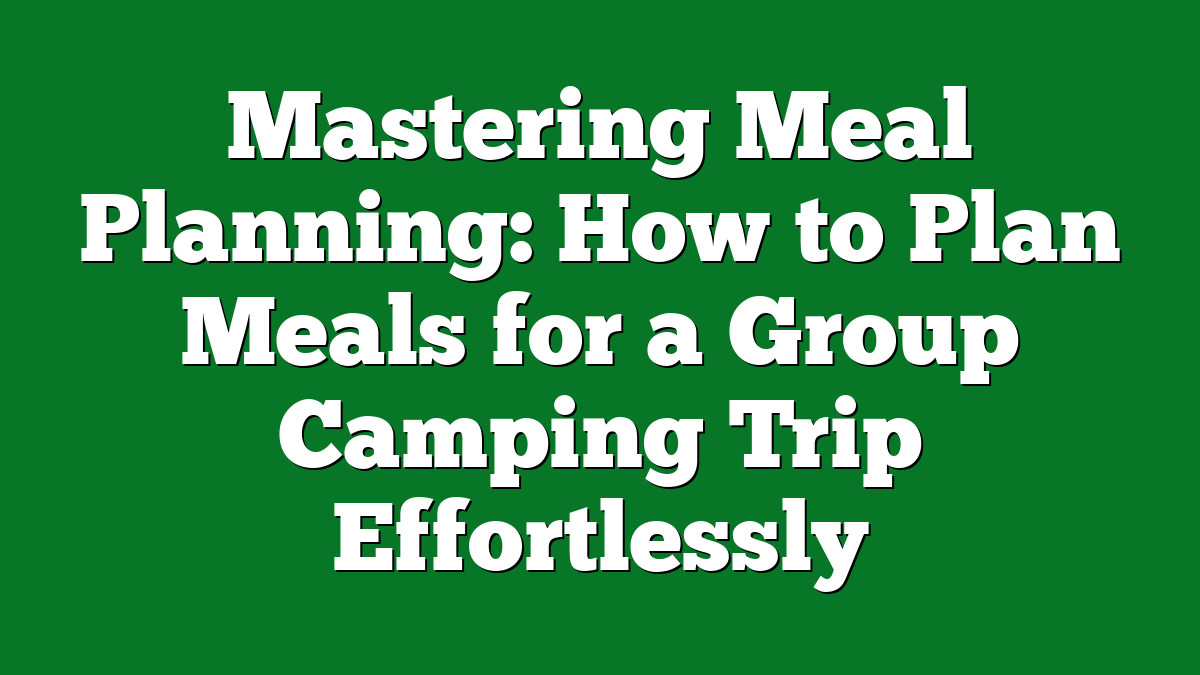Planning meals for a group camping trip can feel like a daunting task, but it doesn’t have to be! With a little organization and creativity, you can whip up delicious dishes that everyone will enjoy. Picture this: a cozy campfire, laughter echoing through the trees, and the smell of mouthwatering food wafting through the air. Sounds perfect, right?
I’ve learned that the key to successful group meals lies in planning ahead. From choosing easy recipes to coordinating dietary preferences, it’s all about making the process smooth and enjoyable. So let’s dive into some tips and tricks that’ll help you create a memorable culinary experience under the stars, ensuring no one goes hungry and everyone leaves with full bellies and happy hearts.
Understanding Group Dynamics
Understanding group dynamics plays a crucial role in meal planning for a camping trip. Recognizing members’ needs contributes to an enjoyable experience. It helps ensure everyone feels included and satisfied during meals.
Assessing Dietary Preferences
Assessing dietary preferences offers insight into what foods each camper enjoys. I suggest initiating conversations about likes and dislikes before the trip. Gather information on whether anyone prefers vegetarian or vegan options, likes spicy foods, or has favorite meals. This information guides recipe choices and encourages group members to contribute their favorite dishes. Sharing these preferences fosters a sense of camaraderie while catering to everyone’s tastes.
Considering Allergies and Restrictions
Considering allergies and restrictions is essential for group safety. I recommend creating a list of known allergies and dietary restrictions before planning meals. Identify members with specific needs, such as gluten intolerance or nut allergies, and prioritize their safety by avoiding those ingredients. When cooking for a group, design recipes that exclude common allergens or provide alternative options. This proactive step reduces anxiety around mealtime and ensures a safe dining experience for everyone involved.
Setting a Budget
Setting a budget for a group camping trip ensures everyone enjoys delicious meals without financial stress. Establishing clear financial expectations makes meal planning more efficient and enjoyable.
Estimating Costs per Person
Estimating costs involves evaluating the number of campers and meal options. I typically calculate an approximate cost of $10 to $15 per person per day for basic meals. This amount accommodates breakfast, lunch, and dinner. For example, if I’m camping with five friends for three days, my rough total would be around $150 to $225. To keep track, I create a simple spreadsheet detailing each meal and its ingredients, allowing me to adjust as needed based on group preferences and any dietary requirements.
Balancing Quality and Quantity
Balancing quality and quantity often affects the overall experience. I focus on utilizing fresh, wholesome ingredients while also ensuring enough food. Prioritizing nutrient-dense foods helps keep energy levels up, especially during outdoor activities. For instance, I choose hearty meals like chili or pasta dishes that provide both satisfaction and calories. I also mix in lighter options like salads or wraps. Buying in bulk when possible reduces costs and minimizes waste, creating a comfortable and enjoyable dining atmosphere around the campfire.
Meal Planning Essentials
When it comes to planning meals for a group camping trip, a bit of foresight goes a long way. I’ve found that creating a structure around your meals not only enhances the experience but also brings everyone together.
Creating a Menu
Creating a menu starts with considering everyone’s preferences and dietary restrictions. I recommend preparing a list of meals, including breakfast, lunch, dinner, and snacks. Include options like oatmeal, granola bars, sandwiches, and stew. A good balance of protein, carbs, and fats keeps everyone energized. For instance, think about pasta dishes paired with vegetables and a protein source like chicken or beans. Not only does this keep the meals simple, but it also allows for easy cooking over a campfire or portable stove.
Importance of Variety
Incorporating variety into your meal plan can keep spirits high and encourage everyone to try new things. Including different types of proteins, grains, and vegetables makes every meal interesting. I suggest alternating between meat-based meals and vegetarian options. For example, one night could feature grilled meat with rice, while the next night could shift to vegetable stir-fry or chili. This approach caters to diverse tastes and prevents meal fatigue, turning every communal dining experience into something to look forward to.
Planning for Leftovers
Planning for leftovers is a smart way to minimize waste and simplify meals. I always cook slightly more than needed, ensuring that easy-to-reheat options are available for lunch the next day or late-night snacks. Dishes like chili or pasta can be packed and reheated on the campfire, making it convenient. If you end up with extra ingredients, consider a make-your-own pizza night using leftover toppings. This flexibility helps in managing supplies while keeping meals exciting.
Cooking and Preparation Tips
Cooking for a group while camping can be a blast, but you need efficient strategies in place. I find that planning meals with easy preparation and cleanup keeps the focus on enjoying the great outdoors.
One-Pot Meals vs. Multi-Ingredient Dishes
One-pot meals shine when it comes to group camping trips. These dishes simplify preparation and cleanup, requiring just one pot or pan. Examples include stews, chili, and pasta dishes; all can feature protein, veggies, and carbs in one go. Multi-ingredient dishes can be impressive but often lead to more dishes and prep time, which isn’t ideal around a campfire. Choosing one-pot meals allows more time for hiking and fishing rather than scrubbing pots.
Pre-Cooking and Packing Strategies
Pre-cooking meals saves time and stress at the campsite. I often prepare dishes like marinated chicken or pasta ahead of time and store them in freezer-safe bags. This method preserves freshness and reduces cooking time. Packing strategies, like labeling bags for each meal, simplify things. Use a cooler with ice packs to keep perishable items safe. For dry goods, opt for resealable bags to minimize space. These techniques ensure I focus on enjoying the experience rather than worrying about what to eat next.
Packing and Storage Solutions
Packing efficiently can make or break a group camping trip. Smart storage choices maximize space and keep food fresh, ensuring meals stay enjoyable.
Choosing the Right Containers
Selecting appropriate containers is crucial for organizing food. I prefer using durable, stackable food storage containers. These containers help prevent spills and keep critters out. Besides that, clear containers allow me to quickly identify contents. I often choose airtight options for dry goods, which prevent moisture and extend shelf life. Utilizing reusable silicone bags also works well for storing snacks or prepped ingredients while reducing waste.
Managing Perishables and Non-Perishables
Managing perishables requires strategy. I pack perishables like fruits, veggies, or proteins in the cooler, ensuring they stay chilled using ice packs or frozen water bottles. I layer ice packs on the bottom, add compartmentalized trays, and top with perishable items, making access easy while keeping food cool. I recommend consuming these foods early in the trip to minimize spoilage.
For non-perishables, I utilize robust bins or bags to store items like canned goods, pasta, and grains. I keep a list of what’s packed to avoid duplicates while ensuring nothing gets left behind. By organizing non-perishables separately, I can quickly access essentials needed for meal prep, which saves time and effort during cooking sessions.
Conclusion
Planning meals for a group camping trip can be a fun and fulfilling adventure. By taking the time to consider everyone’s preferences and dietary needs I can create a menu that keeps everyone happy and energized. With a bit of organization and creativity I can turn meal prep into a bonding experience that enhances our time outdoors.
I’ll remember to keep things simple and flexible while focusing on fresh ingredients and delicious recipes. By packing efficiently and planning for leftovers I can make the most of our meals without adding unnecessary stress. Ultimately it’s all about enjoying great food and making lasting memories around the campfire with friends and family. Happy camping!











